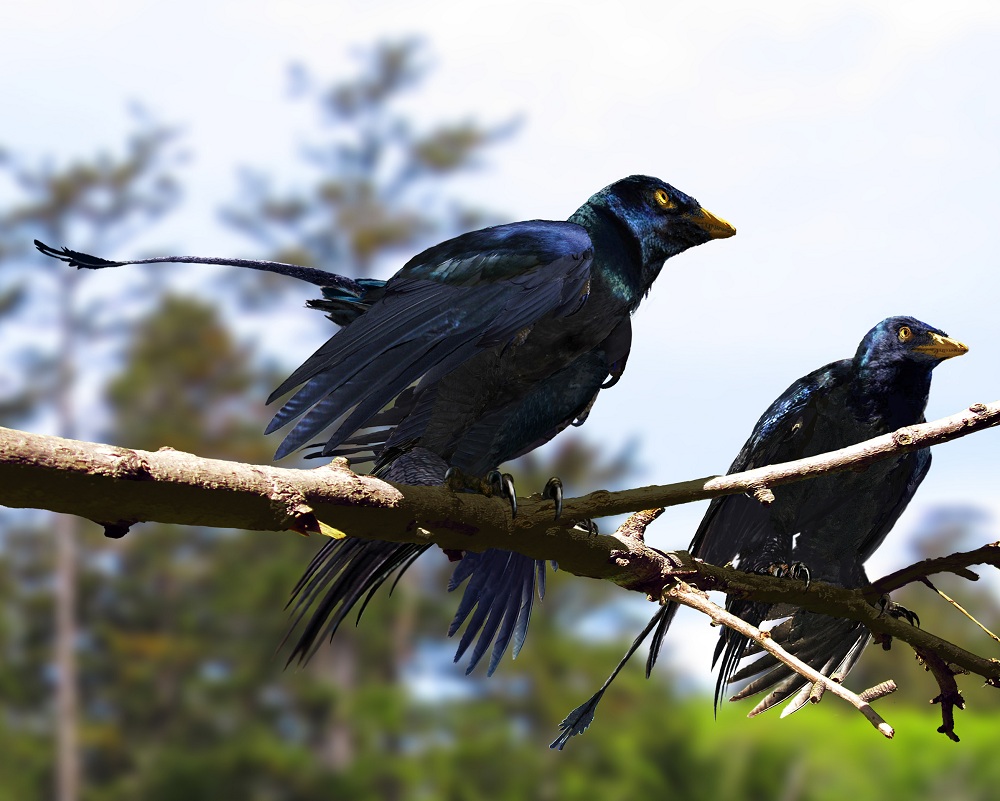True Color of Dinosaur Feathers Debated

The discovery of microscopic color-making structures in fossilized feathers has recently made it possible for scientists to picture dinosaurs and ancient birds in their natural hues.
But a group of researchers warns we might not be able to paint a Microraptor shimmery black or give the giant ancient penguin a maroon and gray coat just yet.
To reconstruct the elusive color of feathered dinosaurs, scientists have zeroed in on melanosomes, melanin-loaded organelles typically present in the cells of the skin, hair and feathers whose colors (which range from black to brown to reddish) are each associated with a specific geometry. Though the visible color of melanosomes often degrades over time, their preserved size, shape and arrangement can give some hints about their original color.
But the melanosomes encased in feather fossils today could have a distorted shape that leads scientists to the wrong conclusion about their true color, according to the new study.
Since scientists don't have hundreds of millions of years to watch how feather fossilization takes place from start to finish, Maria McNamara, of the University of Bristol, and her colleagues simulated a long burial by popping bird feathers into an autoclave, subjecting them to temperatures up to 482 degrees Fahrenheit (250 degrees Celsius) and intense pressure, about 250 times that of the atmosphere. The researchers found that the melanosomes shrank under these harsh conditions. [In Photos: Reconstructing Microraptor's Black Feathers]
Some scientists who have studied the color of fossilized feathers say they took this shrinkage into consideration and don't believe revisions are in order.
Ryan Carney, a researcher at Brown University, worked on a study of the feathers of Archaeopteryx, a species once considered to be the earliest bird that lived about 150 million years ago in what is now Bavaria in Germany. Carney and his colleagues, who published their findings last year, concluded that Archaeopteryx had a black plumage based on an electron microscope-view of hundreds of melanosomes found within a fossil.
Get the world’s most fascinating discoveries delivered straight to your inbox.
Carney told LiveScience that although the melanosomes shrink over time, their original shape leaves an imprint in the rock.
"In the Archaeopteryx feather for example, we found that length and width of melanosomes were significantly smaller compared to those of imprints, and the shrinkage was actually quite similar to that of the McNamara et al. experiment," Carney wrote in an email.
Another researcher, Jakob Vinther, of the University of Bristol, who worked on the Archaeopteryx study — as well as feather-color reconstructions for the giant penguin Inkayacu paracasensis and the Microraptor — echoed Carney's remarks in comments to the journal Nature.
Even so, McNamara said another important finding of her study was that melanosomes survive fossilization even after the disappearance other non-melanin color traces, such as carotenoids, which can create brilliant shades of orange. Yellow, red, green and blue feathers all turned black during the experiments because their non-melanin pigments were destroyed and only the melanosomes survived, McNamara told LiveScience. So finding melanosomes might not necessarily mean the feathers were originally black, brown, or reddish, she added.
"The bottom line is that until we understand how the fossilisation process affects these colour-producing chemicals and structures, and until we know how to look for evidence of these in fossils, there's really no point in attempting to reconstruct colour of feathers based on melanosomes alone," McNamara wrote in an email.
The goal of figuring out the true color of dinosaur feathers goes beyond achieving better paleo-art; colors could offer a rare glimpse into the behavior of long-gone creatures.
As modern animals use their plumage in mating signals, warning signs and camouflage, body color "could yield unique insights into how ancient animals communicated with each other, and how the communication strategies used by modern animals have evolved," McNamara said.
Carney added that color could even give clues about the development of dinosaur flight.
"For example, the melanin in the Archaeopteryx wing feather would not only have provided black coloration, but also increased structural integrity that would have been advantageous during this early evolutionary stage of dinosaur flight," he wrote.
McNamara's results were published March 27 in the journal Biology Letters.
Follow Megan Gannon on Twitter and Google+. Follow us @livescience, Facebook & Google+. Original article on LiveScience.com.



